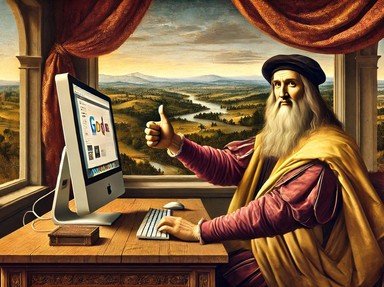Quiz Answer Key and Fun Facts
1. 1889 - The completion of the Eiffel Tower. Here, in our first image at the Museum of AI Anachronisms, we see what looks like an old photograph of a young boy staring at a typewriter and a young girl holding a teddy bear. Which of these two objects was invented after the possible date of this photo?
2. 1492 - Christopher Columbus' voyage to the New World. Two sailors hold two useful items in this illustration. The first is a telescope and the second a firearm known as an arquebus. Which of these two items was invented after the time of this voyage?
3. 1989 - The fall of the Berlin Wall. Here we have two people admiring technological items, a DVD and a handheld gaming console. Which item would NOT yet have been invented the year the Berlin Wall fell?
4. 1540s - The later years of Henry VIII's rule. Two musicians hold court with the king, one holding a lute and the other stationed at a piano. Which of these two instruments could NOT possibly make sense in this painting, as it was invented later?
5. 1945 - The end of WWII. Many soldiers returned home to family life after the horrors of the war. This image shows two types of convenient food, instant coffee and instant noodles. Which of these was invented later than the year of the image?
6. 1776 - The drafting of the U.S. Declaration of Independence. Thomas Jefferson must have been quite stressed at the time of his authorship. A doctor brings two items to assist him: a stovetop tea kettle and a stethoscope. Which of these two items had NOT yet been invented at this time?
7. 1st century BCE - The Roman Empire under Julius Caesar. This beautiful mosaic depicts a Roman farmstead with a farmer working on his field using an iron plow. In the distance, one can see a windmill, with its blades spinning in the wind. Which of these two objects did NOT yet exist in this time period?
8. 1929 - The start of the Great Depression. Most families weren't nearly as lucky as the man in this image, who can seemingly afford multiple appliances. Between the vacuum cleaner and the microwave oven, which could NOT have existed at the time?
9. c. 2600 BCE - The construction of the Great Pyramid of Giza. The ancient Egyptians were incredible architects. Two of their most commonly-used tools, papyrus and the chariot, were used nearly 1000 years apart. Which of the two could NOT feasibly have been in this image, as it was used in Egypt after the Great Pyramid of Giza was finished?
10. 1912 - The voyage of the RMS Titanic. Apparently, at the Museum of AI Anachronisms, when an image involves the Titanic, the objects contained within must also be titanic. Between the ballpoint pen on the left, and the roll of duct tape on the right, which of these two items had NOT yet been invented at the time of this famous ship's demise?
Source: Author
trident
This quiz was reviewed by FunTrivia editor
WesleyCrusher before going online.
Any errors found in FunTrivia content are routinely corrected through our feedback system.
